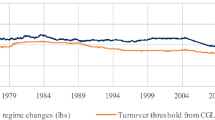Abstract
In this paper, we empirically verify the optimal portfolio schemes for the log-utility investor under incomplete information which converge to the optimal portfolio maximizing the expected log-utility under complete information. That is, our main interest lies in examining whether these schemes really attain the above desired properties, in the NYSE/AMEX stock market. With these properties regarded as performance measures, our empirical research is executed through a sensitivity analysis with transaction costs. Moreover, we show the interesting character of the U.S. stock market exhibited through the analysis.
Similar content being viewed by others
References
Bellman, R. and Kalaba, R. (1957) On the role of dynamic programming in statistical communication theory, IRE Transactions of the Professional Group on Information Theory, IT-3:3, pp. 197–203.
Cover, T. M. (1984) An algorithm for maximizing expected log investment return, IEEE Transactions on Information Theory, IT-30 (March), pp. 369–373.
Cover, T. M. (1991) Universal portfolios, Mathematical Finance 1 (January), 1–29.
Cover, T. M. and Ordentlich, E. (1996) Universal portfolios with side information, IEEE Transactions on Information Theory, IT-42 (March), pp. 348–363.
Elton, E. J. and Gruber, M. J. (1995) Modern Portfolio Theory and Investment Analysis, 5th edn, John Wiley & Sons.
Fama, E. F. (1970), Efficient Capital Market: A Review of Theory and Empirical Work, J. Finance, 25, 383–417.
Fama, E. F. and French, K. R. (1988), Permanent and Temporary Components of Stock Prices, J. Polit. Economy 96, 246–273.
Fama, E. F. (1991), Efficient Capital Markets: II, J. Finance 46, 1575–1617.
Grauer, R. R. and Hakansson, N. H. (1982) Higher return, lower risk: Historical returns on longrun, actively managed portfolios of stocks, bonds, and bills, 1936–1978, Financ. Anal. J. 38 (Mar—Apr), 39–53.
Grauer, R. R. and Hakansson, N. H. (1985) Returns on levered, actively managed long-run portfolios of stocks, bonds, and bills, 1934–1984, Financ. Anal. J. 41 (Sep—Oct), 24–43.
Grauer, R. R. and Hakansson, N. H. (1986), A half century of returns on levered and unlevered portfolios of stocks, bonds, and bills, with and without small stocks, J. Busin. 59, 287–318.
Grauer, R. R. and Hakansson, N. H. (1987), Gains from international diversification: 1968–85 returns on portfolios of stocks and bonds, J. Finance 42, 721–739.
Ishijima, H. and Shirakawa, H. (1999) The optimal log-utility asset management under incomplete information, forthcoming in Asia-Pacific Financial Markets.
Jamshidian, F. (1992), Asymptotically optimal portfolios, Mathematical Finance 2 (April), 131–150.
Konno, H. (1995) Financial Engineering: Mean-Variance Model and its Extensions (in Japanese), Nikkagiren.
Mossin, J. (1968) Optimal multiperiod portfolio policies, J. Busin. 41 (April), 215–229.
Poterba, J. M. and Summers, L. H. (1988) Mean reversion in stock prices: Evidence and implications, J. Financ. Econom. 22, 27–59.
Shirakawa, H. and Ishijima, H. (1997) Stochastic analysis of continuous time universal portfolio, Working Paper, Tokyo Institute of Technology.
Author information
Authors and Affiliations
Rights and permissions
About this article
Cite this article
Ishijima, H. An Empirical Analysis on Log-Utility Asset Management. Asia-Pacific Financial Markets 6, 253–273 (1999). https://doi.org/10.1023/A:1010076022308
Issue Date:
DOI: https://doi.org/10.1023/A:1010076022308




